Written by: Marieke Zaffron
What else do you screen your patients for during the dental examination? Do you have them fill out a questionnaire before their appointment? Or is that only for new patients? Do you find time to ask them questions about their health? Or do trust that the patient will tell you if something is wrong?
For many patients, they see you and your hygiene staff more often than any other medical professional. The patient may not realize that an annoying but nonpainful symptom such as TMJ clicking might be a sign of something more serious, and they may not bring it up unless prompted. No one is expecting the dentist to perform a comprehensive physical exam, but there are several key areas of the head, neck, and mouth where asking a few brief questions and taking a closer look could potentially make a world of difference to your patients’ health.
Tongue Screening
Let’s start in the oral cavity—we’re already there, right? How much attention are you giving to your patients’ tongues? According to Drs Andreas Filippi and Irène Hitz Lindenmüller, editors of The Tongue (Quintessence, 2019), “the borders, underside, and base of the tongue as well as the floor of the mouth should be inspected as a basic principle. If there are any visible or merely palpable changes, further diagnostic investigation should be discussed.” Ask the patient if they’ve had any reduced saliva flow or burning sensation of the tongue. Dozens of medical conditions—oral and general—present with signs and symptoms in the tongue, so it’s important to recognize any abnormalities that might be cause for concern. Even something as simple as a change in the color of the tongue might indicate problems.

A thorough tongue examination includes pulling the tongue out with a swab to allow the entire border of the tongue to be evaluated.
Oral Pathology Screening
A patient may have immaculate oral hygiene, no gingival recession or caries, and perfect teeth that need no management beyond the daily brushing and flossing. But that doesn’t mean they are free from oral diseases. As Dr Robert Marx, author of Oral Pathology in Clinical Practice (Quintessence, 2017) points out, “Dentists and their dental hygiene team historically have been the great identifiers of oral diseases—not only the common ones of dental caries and periodontal inflammation but also those of oral cancers, serious infections, systemic diseases, and many more.” In fact, taking notice of an unusual lesion and referring the patient to the correct specialist to identify it further can even save a life. Dr Marx recommends taking a close look at “the more hidden places in the oral cavity such as the posterior lingual mandible, the hamular notch area, and the posterior lateral border of the tongue … it is also prudent to examine the face and neck for obvious skin lesions and masses as well as the patient’s overall appearance and gait.” In addition, having a basic knowledge of oral pathology can help you to direct your patients to the correct specialist when there is a problem. In cases of certain cancers, time may be of the essence.

Squamous cell carcinoma that was incorrectly diagnosed and treated as gum disease for 2 years, giving the cancer time to invade the bone.
Orofacial Pain/TMD Screening
Now that we’ve covered the mouth, let’s move on to the rest of the head. Getting a correct orofacial pain diagnosis is especially important for dentists because of the prevalence of referred pain, or pain that is felt in one area even if the painful stimulus originates somewhere else. Your patients may be complaining of a toothache when the tooth itself is actually fine, but the patient has an undiagnosed pain disorder affecting the trigeminal nerve. Imagine if the patient was put through root canal treatment—or even had the tooth extracted—only for the pain to remain and the real problem to remain unresolved.
Drs Reny de Leeuw and Gary Klasser, editors of the sixth edition of Orofacial Pain: Guidelines for Assessment, Diagnosis, and Management (Quintessence, 2018), encourage dentists to screen all of their patients for TMDs and other orofacial pain disorders. The actual process of diagnosing a pain disorder can be involved, requiring a comprehensive history and clinical examination as well as diagnostic tests. However, adding a few simple screening questions to the dental exam is a great place to start. A positive response to any of these questions may be sufficient to warrant further investigation, including referral to a specialist.

Example screening questions for TMDs.
Sleep Apnea/Hypopnea Screening
Obstructive sleep apnea/hypopnea is a serious concern affecting 65 million Americans. Although sleep dentistry is developing as a specialty of its own, even general dentists should be aware of some of the basics to screen their patients. As Drs Gilles Lavigne, Peter Cistulli, and Michael Smith, editors of the new edition of Sleep Medicine for Dentists (Quintessence, 2020) put it, “It is generally accepted that the dentist’s role is to screen for potential sleep-disordered breathing (SDB) but not to diagnose SDB … Because patients with SDB may present to their dentist before their medical doctor, dentists have the potential to recognize patients with SDB who might not otherwise be diagnosed.” Both children and adults can suffer from SDB, so pediatric patients should be screened as well as older patients.
Screening for sleep disorders includes questioning patients on their sleep habits. Consider having your patients fill out a validated sleep questionnaire as part of their history forms. Check for the following symptoms of SDB.

Symptoms related to SDB.
Conclusion
Most patients don’t go to their dentists expecting to be diagnosed with a problem unrelated to their teeth. And of course, you probably won’t be the one doing the actual diagnosing for concerns that aren’t strictly dental. But even so, taking that extra step and being able to tell patients when they might have a problem, and having someone in your back pocket to refer them to so they can get the help they may need, can make all the difference.
Check out the titles below for more information on each of these topics.
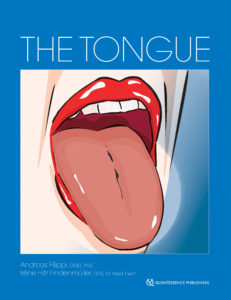 The Tongue
The Tongue
Edited by Andreas Filippi and Irène Hitz Lindenmüller
As the largest organ in the oral cavity, the tongue not only plays a primary role in masticatory and speech function—it is also a significant indicator of health, demonstrating signs of both oral pathologies and diseases that can affect the entire body. Because no health care provider gets the opportunity to examine a patient’s tongue as often as the dentist, it is essential for dentists to recognize when there may be a problem with the tongue and what the problem is. In addition to an overview of tongue anatomy and general diagnosis and treatment recommendations, this book contains an atlas of more than 50 specific diseases and health concerns that may present signs and symptoms in the tongue. Each is outlined in a quick-reference table describing etiology, prognosis, and more and is accompanied by photographs of different ways the condition can present. A true diagnostic aid, this guide will allow clinicians to identify and address any abnormality a patient’s tongue may exhibit.
216 pp; 591 illus; ISBN: 978-0-86715-776-5; 9780867157765; US$148
Learn more here: What Dentists Should Know About Treating the Tongue
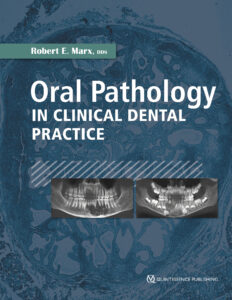 Oral Pathology in Clinical Practice
Oral Pathology in Clinical Practice
By Robert E. Marx
While most dentists do not perform their own histologic testing, all dentists must be able to recognize conditions that may require biopsy or further treatment outside the dentist office. This book does not pretend to be an exhaustive resource on oral pathology; instead, it seeks to provide the practicing clinician with enough information to help identify or at least narrow down the differential for every common lesion or oral manifestation of disease seen in daily practice as well as what to do about them. Organized by type of lesion, mass, or disease, each pathologic entity presented includes the nature of the disease; its predilections, clinical features, radiographic presentation, differential diagnosis, and microscopic features; and the suggested course of action for the dental practitioner as well as the standard treatment regimen. In keeping with the concise nature of the text, all but the rarest disease entities include at least one photograph to illustrate the clinical condition. This book distills the comprehensive information from Dr Marx and Dr Diane Stern’s award-winning pathology reference text (Oral and Maxillofacial Pathology: A Rationale for Diagnosis and Treatment, Second Edition [Quintessence, 2012]) into practical guidelines for restorative and general dentists everywhere.
376 pp; 425 illus; ISBN: 978-0-86715-764-2; 9780867157642; US$98
Learn more here: Clinical Pathology for Your Clinic
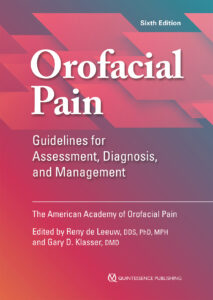 Orofacial Pain: Guidelines for Assessment, Diagnosis, and Management, Sixth Edition
Orofacial Pain: Guidelines for Assessment, Diagnosis, and Management, Sixth Edition
Edited by Reny de Leeuw and Gary D. Klasser
Following in the tradition of the previous editions, this book offers the latest research and most up-to-date information on orofacial pain, including a concise overview of each condition as well as its symptoms, comorbidities, differential diagnosis, and treatment options. Every chapter has undergone critical updates to reflect the developments in the expanding field of orofacial pain, including the glossary. These updates include the addition of new diseases such as first-bite syndrome, revised information on genetic factors to reflect new insights gleaned from the OPPERA studies, expanded information on management strategies for certain conditions, and revisions to screening tools for biobehavioral factors. In addition, the classification system used in the fifth edition has been replaced and extended and includes DSM-5 codes where applicable. This book remains an essential tool for any health care provider who treats patients with orofacial pain.
336 pp; (softcover); 9 illus; ISBN: 978-0-86715-768-0; 9780867157680; US$56
Learn more here: Orofacial Pain Management in Dentistry
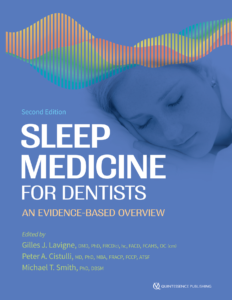 Sleep Medicine for Dentists: An Evidence-Based Overview, Second Edition
Sleep Medicine for Dentists: An Evidence-Based Overview, Second Edition
Edited by Gilles J. Lavigne, Peter A. Cistulli, and Michael T. Smith
Dentists are often the first medical practitioners to encounter patient reports or clinical evidence of disorders such as sleep apnea, sleep bruxism, and sleep-disrupting orofacial pain, providing them a unique opportunity to prevent the development or persistence of conditions that strongly impact their patients’ lives. Since the first publication of this seminal book, significant advances have been made in the field of sleep medicine, and this updated edition gathers all of this new evidence-based knowledge and presents it in focused, concise chapters. Leading experts in medicine and dentistry explain the neurobiologic mechanisms of sleep and how they can be affected by breathing disorders, bruxism, and pain, along the way guiding dental practitioners in performing their specific responsibilities for screening, treating, and often referring patients as part of a multidisciplinary team of physicians. An emphasis is placed on research findings regarding newly emerging cognitive behavioral approaches to treatment that mitigate some of the risks associated with pharmacologic and oral appliance therapies. Readers will find this book both fascinating and clinically important as they strive to provide the best possible treatment to patients with these complex and often life-threatening disorders.
224 pp; 40 illus ISBN: 978-0-86715-828-1; 9780867158281; US$78
Learn more here: Obstructive Sleep Apnea, the Didgeridoo, and You
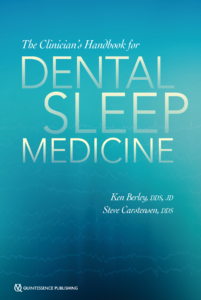 The Clinician’s Handbook for Dental Sleep Medicine
The Clinician’s Handbook for Dental Sleep Medicine
Edited by Ken Berley and Steven Carstensen
It has been estimated that 20 million Americans suffer from moderate to severe OSA, and at least one patient in five has mild OSA. The primary treatment prescribed by sleep physicians is CPAP, but patient compliance with this therapy is unacceptably low, between 25% and 50%. There is a significant opportunity for dentists to provide a viable alternative therapy—oral appliance therapy (OAT). OAT results in much better adherence to therapy than CPAP, and while OAT is not as efficacious as CPAP, this increased compliance results in comparable therapeutic results. Currently, a board-certified sleep physician is the only medical professional qualified to diagnose OSA and other sleep-related breathing disorders (SRBDs), so dentists must coordinate with a sleep physician to provide OAT. This book is the how-to guide, a gateway to a successful dental sleep medicine practice. Written by two experts in the field, it clearly delineates the dentist’s role in the treatment of SRBDs and gives practical advice for how to incorporate dental sleep medicine into an existing dental practice, not to mention how to work with sleep physicians to best support patient care. In addition to step-by-step instructions for examination, appliance selection, and follow-up care, complications of OAT, legal issues, and medical insurance and Medicare considerations are included to fully prepare the dentist for the journey into dental sleep medicine.
240 pp; (softcover); 60 illus; ISBN: 978-0-86715-813-7; 9780867158137; US$72
Learn more here: Obstructive Sleep Apnea: A Deadly Disease with a Dental Solution
